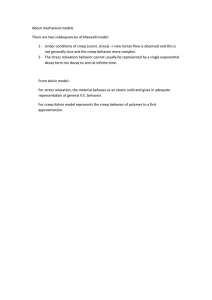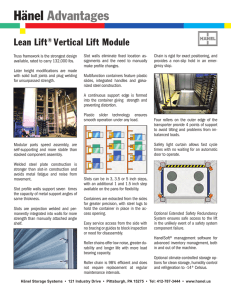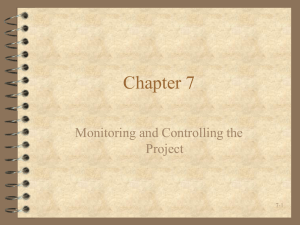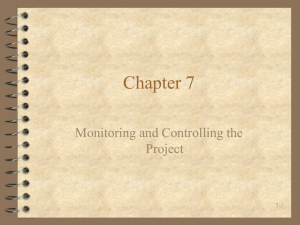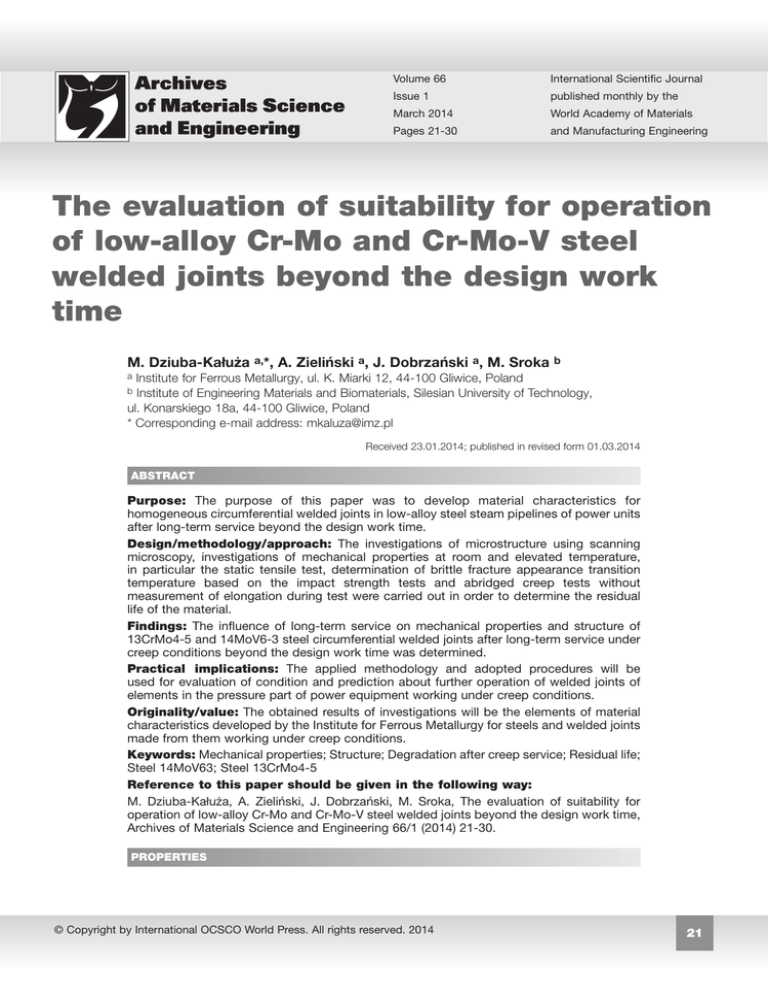
Volume 66
International Scientific Journal
Issue 1
published monthly by the
March 2014
World Academy of Materials
Pages 21-30
and Manufacturing Engineering
The evaluation of suitability for operation
of low-alloy Cr-Mo and Cr-Mo-V steel
welded joints beyond the design work
time
M. Dziuba-Kałuża a,*, A. Zieliński a, J. Dobrzański a, M. Sroka
b
a
Institute for Ferrous Metallurgy, ul. K. Miarki 12, 44-100 Gliwice, Poland
Institute of Engineering Materials and Biomaterials, Silesian University of Technology,
ul. Konarskiego 18a, 44-100 Gliwice, Poland
* Corresponding e-mail address: mkaluza@imz.pl
b
Received 23.01.2014; published in revised form 01.03.2014
ABSTRACT
Purpose: The purpose of this paper was to develop material characteristics for
homogeneous circumferential welded joints in low-alloy steel steam pipelines of power units
after long-term service beyond the design work time.
Design/methodology/approach: The investigations of microstructure using scanning
microscopy, investigations of mechanical properties at room and elevated temperature,
in particular the static tensile test, determination of brittle fracture appearance transition
temperature based on the impact strength tests and abridged creep tests without
measurement of elongation during test were carried out in order to determine the residual
life of the material.
Findings: The influence of long-term service on mechanical properties and structure of
13CrMo4-5 and 14MoV6-3 steel circumferential welded joints after long-term service under
creep conditions beyond the design work time was determined.
Practical implications: The applied methodology and adopted procedures will be
used for evaluation of condition and prediction about further operation of welded joints of
elements in the pressure part of power equipment working under creep conditions.
Originality/value: The obtained results of investigations will be the elements of material
characteristics developed by the Institute for Ferrous Metallurgy for steels and welded joints
made from them working under creep conditions.
Keywords: Mechanical properties; Structure; Degradation after creep service; Residual life;
Steel 14MoV63; Steel 13CrMo4-5
Reference to this paper should be given in the following way:
M. Dziuba-Kałuża, A. Zieliński, J. Dobrzański, M. Sroka, The evaluation of suitability for
operation of low-alloy Cr-Mo and Cr-Mo-V steel welded joints beyond the design work time,
Archives of Materials Science and Engineering 66/1 (2014) 21-30.
PROPERTIES
© Copyright by International OCSCO World Press. All rights reserved. 2014
21
M. Dziuba-Kałuża, A. Zieliński, J. Dobrzański, M. Sroka
1.
Introduction
1. Introduction
In the evaluation of the degradation of critical elements
of power units after long-term service under creep
conditions working above 150 000 hours and in order to
determine their suitability for further operation, the
comprehensive tests the selection of which depends on, but
is not limited to, the type and working conditions of the
analysed structural component as well as its accessibility
are required. In the evaluation of structural components
working under creep conditions, the condition assessment
of their material as well as HAZ material and welds in the
used welded joints is necessary [3-8]. To estimate and
determine the time of safe operation for the material of
critical elements of power units working under creep
conditions, particularly when the design work time has
been exceeded, the knowledge of their residual creep
strength is necessary. For the materials of welded joints the
abridged creep tests without measurement of elongation
during test were carried out to determine creep strength
characteristics for the material of circumferential welded
joints made from low-alloy steels. Based on the abridged
creep tests using the Larson-Miller parametric relationship,
the residual creep strength characteristics will be
determined. These characteristics should allow good
estimation of residual life and disposable residual life for
various levels of working stresses Vr within the range of
working temperatures Tr. The knowledge of the ability to
transfer the loads of material and welded joints due to
periodical shutdowns and start-ups of the boiler connected
with periodical inspections and repairs as well as failures,
and also with water pressure tests is essential too.
Therefore, apart from residual creep strength, the
knowledge of the basic strength and plastic properties in
connection with the image of the elements of welded joints
after long-term service under creep conditions is also
important [9-16].
2.
Material for
2. Material
forinvestigations
investigations
The material for investigations included the test
specimens of selected elements in the pressure part of boilers
with homogeneous circumferential welded joints from
14MoV6-3 and 10CrMo9-10 pursuant to PN-75/H-84024
low-alloy steel after long-term service under creep
conditions much beyond the assumed time. The summary
of materials for investigations is presented in Fig. 1.
22
22
40
Ø 324
Material for investigations:
circumferential welded joint
16
Ø 508
Fig. 1. Material for investigations in the form of
homogeneous circumferential welded joint after 240 000 h
service under creep conditions: a) primary steam pipeline
from 14MoV63 steel (marked 1); b) secondary steam
pipeline 10CrMo9-10 (marked 2)
Chemical composition of the materials of tested
specimens of the primary and secondary steam pipelines
with reference to the requirements of the standard
specification is presented in Table 1. The results of check
analysis of chemical composition revealed that the
materials of tested specimens from critical elements in the
pressure parts of power units after long-term service under
creep conditions met the requirements of the standard with
regard to chemical composition of tested 14MoV6-3 and
10CrMo9-10 steels.
3.
Range of
3. Range
of investigations
investigations
At specific points within the material from the acquired
specimens for investigations, the following non-destructive
tests were carried out: mechanical testing, microstructure
investigation and creep strength tests. Based on the
obtained test results the material condition assessment is
made and the creep strength, which is the residual creep
strength, is determined for working parameters of further
operation (temperature and stress). By knowing the residual
creep strength for parameters of further operation, the
disposable residual life can be determined, which is the
expected time of further safe service for the adopted
working parameters.
Archives of Materials Science and Engineering
The evaluation of suitability for operation of low-alloy Cr-Mo and Cr-Mo-V steel welded joints beyond the design work time
Table 1.
Chemical composition of the material of tested specimens after long-term service under creep conditions
Content of elements, %
Grade of
material
C
Mn
Si
P
S
Cu
Cr
Ni
PN-75/H84024
0.10
0.40
0.15
max
max
max
0.30
max
14MoV6-3
0.18
0.70
0.35
0.04
0.04
0.25
0.60
0.30
(13HMF)
14MoV6-3
(13HMF)
0.12
0.41
0.27
0.015
0.020
0.088
0.45
0.075
after 240 000 h
marked 1
Grade of
C
Mn
Si
P
S
Cu
Cr
Ni
material
PN-75/H84024
0.08
0.40
0.15
max
max
max
2.00
max
10CrMo9-10
0.15
0.60
0.50
0.03
0.03
0.25
2.50
0.30
(10H2M)
10CrMo9-10
(10H2M)
0.082
0.42
0.28
0.007
0.015
0.074
2.25
0.089
after 240 000 h
marked 2
4.
Test results
4. Test
results
4.1.
properties
4.1. Evaluation
Evaluationofofmechanical
mechanical
properties
and structure of the material
and
Evaluation of mechanical properties
The investigations of strength properties were carried
out as a part of the tensile test at room temperature and at
elevated temperature similar to the real operating
temperature. The obtained results of the tensile strength
(TS) and yield point (YP) tests are shown in Fig. 2a,
while the results of impact energy tests, carried out on
longitudinal test pieces with V notches cut
perpendicularly to the surface of tested pipes – in Fig. 2b.
The impact energy tests were carried out at temperature
levels selected so that the brittle fracture appearance
transition temperature can be determined for the material
of tested elements.
Investigations of microstructure
The investigations of microstructure were carried out on
microsections following grinding, polishing and etching.
The observations were conducted using Inspect F scanning
electron microscope with magnifications of 500, 1000,
2000 and 5000x. The results of the investigations in the
form of material structure images are presented in Fig. 3.
Issue 1 March 2014
0.50
0.65
others
V 0.220.35
Al max
0.02
0.52
V 0.28
Mo
others
0.90
1.10
Al max
0.020
1.01
Al 0.007
a)
structure of the material
Volume 66
Mo
14MoV6-3
Marked 1
10CrMo9-10
Marked 2
Fig. 2. Results of mechanical testing of the material of
tested specimens with homogeneous circumferential
welded joint after 240 000 h service under creep
conditions: a) tensile strength and yield point at room and
elevated temperature
23
M. Dziuba-Kałuża, A. Zieliński, J. Dobrzański, M. Sroka
a)
b)
Impact energy KV, J
14MoV6-3 steel
Marked 1
HAZ2
PM2
W
Impact energy KV, J
1 cm
PM1
HAZ1
PM2
HAZ2
b)
W
Circumferential
welded joint from
14MoV6-3 steel
Marked 1
Impact energy KV, J
10CrMo9-10 steel
Marked 2
HAZ1
PM1
Impact energy KV, J
Circumferential welded
joint from 10CrMo9-10
steel (Marked 2)
Fig. 2. Results of mechanical testing of the material of
tested specimens with homogeneous circumferential welded
joint after 240 000 h service under creep conditions:
b) impact energy at different test temperature levels for
14MoV6-3 steel primary steam pipeline (marked 1) and
10CrMo9-10 steel secondary steam pipeline (marked 2)
The description of microstructure including the review of
results and exhaustion extent te/tr estimated based on
proprietary classification of the Institute for Ferrous
Metallurgy is provided in Table 2.
24
HAZ1
W
PM1
24
W
HAZ2
PM2
1 cm
PM1
HAZ1
PM2
HAZ2
Fig. 3. Comparison of microstructure of the elements of
welded joint: MR, HAZ and SP of: a) 14MoV63 primary
steam pipeline (marked 1); b) 10CrMo9-10 secondary
steam pipeline (marked 2); SEM
Archives of Materials Science and Engineering
The evaluation of suitability for operation of low-alloy Cr-Mo and Cr-Mo-V steel welded joints beyond the design work time
Table 2.
Review of the results of investigations of microstructure of the elements of homogeneous circumferential welded joint after
240 000 h service under creep conditions
Description of microstructure
Hardness
Material for investigations
Material condition – exhaustion extent
HV10
Ferritic-bainitic structure. Partially coagulated bainitic areas.
Element: Primary
At the ferrite grain boundaries, there are precipitates of different
steam pipeline
size, mostly fine. Inside the ferrite grains, there are very fine
evenly distributed precipitates.
PM
No
discontinuities
and micro-cracks are observed in the structure.
156
Grade: 14MoV6-3
No
initiation
of
damaging
processes
is
observed.
(13HMF)
Bainitic areas: class I, precipitates: class a
Damaging processes: class O
CLASS 1/2, EXHAUSTION EXTENT: approx. 0.3
Service time: 240 000 h
HAZ
Heat-affected zone structure.
service
191
No discontinuities and micro-cracks are found in the structure.
designation ZGP1
W
Structure of weld material in welded joint.
189
No discontinuities and micro-cracks are found in the structure.
Ferritic-bainitic structure. Partially coagulated bainitic areas.
Element: Secondary
At the ferrite grain boundaries, there are precipitates, some of
steam pipeline
rather significant size, forming chains in places. Inside the ferrite
grains, there are numerous, mostly fine, precipitates.
PM
No discontinuities and micro-cracks are observed in the structure.
149
Grade: 10CrMo9-10
No initiation of damaging processes is observed.
(10H2M)
Bainitic areas: class I, precipitates: class a
Damaging processes: class O
CLASS 1/2, EXHAUSTION EXTENT: approx. 0.3
Service time: 240 000 h
Heat-affected zone structure.
service
HAZ
172
No discontinuities and micro-cracks are found in the structure.
Structure of weld material in welded joint.
designation ZGP1
W
201
No discontinuities and micro-cracks found in the structure.
Abridged creep tests
To reduce the time of creep tests and evaluation of
residual life, the abridged creep tests of a few dozen to max
3 to 5 thousand hours were used. This makes it possible to
obtain test results within maximum several months, yielding
good estimation of residual life. The acceleration of the
creep process and reduction in the time of testing is obtained
in creep tests carried out at uniaxial tension on test pieces
taken from the tested material by conducting the tests [1,2]:
x at constant test stress corresponding to the operating
one and at different levels of test temperature, much
higher than the operating one,
x at constant test temperature corresponding to the
operating one and at different levels of test stress, much
higher than the operating ones.
High concurrence of results obtained in abridged creep
tests conducted at a constant stress corresponding to the
Volume 66
Issue 1 March 2014
operating one and in long-term creep tests conducted as
a part of in-house investigations carried out at the Institute
for Ferrous Metallurgy verified this method positively and
allowed its use in the engineering practice.
Therefore, the abridged creep tests were carried out for
the tested materials and welded joints made from them.
The tests were carried out at constant test stress level
corresponding to the operating one ıb= ır =const and at
constant test temperature Tb for each of the tests, but with
different values ranging between 620ºC and 700ºC in 20ºC
steps. The test results are presented in the form of
relationship log tr =f(Tb) at ıb = const, where tr is the time
to rupture in creep test. They allow the straight line
inclined towards the time to rupture tr axis to be outlined.
The residual life is determined by extrapolation of the
obtained line towards the lower temperature corresponding
to the operating one Te.
25
M. Dziuba-Kałuża, A. Zieliński, J. Dobrzański, M. Sroka
The obtained results of abridged creep tests for the
material of pipeline and circumferential welded joint in the
tested specimen of 14MoV6-3 steel primary steam pipeline
(marked 1) after 240 000 h service under creep conditions
conducted at constant stress level ıb = 60 MPa,
corresponding to the assumed working stress ır of further
operation, are presented in the form of relationship tr = f(Tb)
at ıb § ır in Fig. 4 and summarised in Table 3, while the
a)
obtained results of abridged creep tests for the material of
pipeline and circumferential welded joint in the tested
specimen of 10CrMo9-10 steel secondary steam pipeline
(marked 2) after 240 000 h service under creep conditions
conducted at constant test stress level ıb = 55 MPa,
corresponding to the assumed working stress ır of further
operation, are presented in the form of relationship tr = f(Tb)
at ıb § ır in Fig. 5 and summarised in Table 3.
b)
1000000
extrapolation
extrapolation
Time to rupture, Tr, h
Czas
zerwania
Time do
to rupture,
Tr, thr, h
100000
ıb=60MPa
10000
1000
100
14MoV6-3
(Marked 1)
240 000 h
10
ıb=60MPa
Circumferential
welded joint from
14MoV6-3 10 steel
(Marked 1)
240 000 h
1
540
te
560
580
600
620
640
660
680
700
te
Temperatura
badaniaºC
Tb, oC
Test temperature,
Test temperature, ºC
Fig. 4. Results of abridged creep tests of: a) pipeline material; b) circumferential welded joint of the 14MoV6-3 (13HMF)
steel primary steam pipeline after 240 000 h service under creep conditions, as relationship logtre=f(Tb) at Vb=60MPa
a)
b)
Test in progress
extrapolation
10CrMo9-10
(Marked 2)
240 000 h
Test temperature, ºC
Timetotobreak
rupture,
Time
tr,Thr, h
Time to rupture, Tr, h
extrapolation
ıb=55MPa
Circumferential welded
joint form 10CrMo9-10
steel (Marked 2)
240 000 h
te
Test temperature,
temperature, ºC
Tb, °C
Test
Fig. 5. Results of abridged creep tests of: a) pipeline materials; b) circumferential welded joint of the 10CrMo9-10 (10H2M)
secondary steam pipeline after 240 000 h service under creep conditions, as relationship logtre=f(Tb) at Vb=55MPa
26
26
Archives of Materials Science and Engineering
The evaluation of suitability for operation of low-alloy Cr-Mo and Cr-Mo-V steel welded joints beyond the design work time
Table 3.
Results of abridged creep tests at constant test stress level and for different levels of temperature higher than the expected
operating one for the material of circumferential welded joint of the specimen of the main 14MoV6-3 steel primary steam
pipeline (marked 1) and 10CrMo9-10 steel secondary steam pipeline (marked 2) after 240 000 h service
Material for investigations
Test temperature Tb, °C
Test stress
Steel grade
Working
parameters
620
640
660
680
700
Dim.
Vb,
specimen design Dz x gn, Press. pr, Temp. tr,
MPa
Time to rupture tz, h
mm
MPa
°C
1
2
3
4
5
6
7
8
9
10
Parent material
14MoV6-3
3197
1096
331
93
33
(13HMF)
Marked 1
Welded joint of
324x40
14.0
540
60
the primary
steam pipeline
2495
782
288
116
41
14MoV6-3
(13HMF)
Marked 1
Parent material
10CrMo9-10
(1500)
956
480
139
31
(10H2M)
Marked 2
Welded joint of
508x16
3.0
540
55
the secondary
steam pipeline
2023
688
166
75
20
10CrMo9-10
(10H2M)
Marked 2
Based on the completed abridged creep tests and
applied extrapolation method, the residual life was
determined and the disposable residual life, which is the
time of further safe service for the working parameters of
stress ır and temperature Tr, was evaluated. The obtained
results of extrapolation based on creep tests are
summarised in Table 4.
4.2.
condition
assessment
and
4.2. Material
Material
condition
assessment
and
determination of residual life – discussion
determination
of residual life – discussion of
of the results
the results
The condition assessment of the material of tested
circumferential welded joints of the main 14MoV6-3 steel
primary steam pipeline (marked 1) and 10CrMo9-10 steel
secondary steam pipeline (marked 2) after 240 000 h
service was made based on joint assessment of the obtained
Volume 66
Issue 1 March 2014
results of mechanical testing, structure investigation and
residual creep strength test.
For the 14MoV6-3 steel primary steam pipeline after
240 000 h service, the requirements for yield point at
room temperature for both the parent material and
welded joint and the requirements with regard to yield
point at a temperature similar to the operating one for the
parent material are not met. Also, the brittle fracture
appearance transition temperature for the parent material
of the tested 14MoV6-3 steel pipeline is positive and
equals to +12°C.
For the 10CrMo9-10 steel secondary steam pipeline
after 240 000 h service the requirement for tensile
strength at room temperature Rm, yield point at room
temperature Re min and min. yield point Ret at
a temperature similar to the operating one is met. Also,
the brittle fracture appearance transition temperature for
both the parent material and the circumferential welded
joint is negative.
27
M. Dziuba-Kałuża, A. Zieliński, J. Dobrzański, M. Sroka
Table 4.
Residual life and disposable residual life based on abridged creep tests of the materials of tested circumferential welded
joints of the main 14MoV6-3 steel primary steam pipeline (marked 1) and 10CrMo9-10 steel secondary steam pipeline
(marked 2) after 240 000 h service
Material for investigations
No.
Steel grade
specimen
designation
1
2
1
14MoV6-3
(13HMF)
Marked 1
10CrMo9-10
(10H2M)
Marked 2
Element
of the joint
Dim.
Dzxgn,
mm
3
4
Assumed
operating stress
ır, MPa
Assumed
temperature
of further
operation Tr, ºC
5
6
Parent material
Welded joint of
the primary
steam pipeline
324x40
Parent material
60
Estimated life time,
h 1)
residual
tre
disposable
residual tb
7
8
200 000
110 000
100 000
55 000
300 000
165 000
540
Welded joint of
55
540
the secondary
508x16
200 000
steam pipeline
Note: 1.) Provided that plastic strain after the current long-term service does not exceed max 1%
2
The above-mentioned information is necessary to take
a decision in the event when pressure test is required. This
test must then take into consideration the level of these
properties in the selection of water pressure test
parameters. This can only be the leak proof test of the
pipeline, not the strength test. As the brittle fracture
appearance transition temperature of parent material of the
14MoV6-3 (13HMF) steel primary steam pipeline after
240 000 h service is positive, the required boiler start-up
and shutdown conditions should be followed absolutely.
The obtained results of mechanical testing in
combination with the results of structure investigations for
the primary and secondary steam pipeline show slight
wear-out of the tested material the exhaustion extent te/tr of
which was estimated to be approx. 0.3.
Also, hardness of tested elements of the circumferential
welded joints for critical elements in the pressure part of
power units is much lower than the maximum admissible
hardness of 350 HV, ranging between approx. 156 and
approx. 191 HV10 for the 14MoV63 steel primary steam
pipeline, while for the 10CrMo9-10 steel secondary steam
pipeline it ranges between approx. 149 and approx.
201 HV10. The course of changes in hardness at the
transition through individual zones of the joints is mild.
28
28
110 000
This allows to judge that the tested welded joints will be
able to transfer the required considerable loads, including
those that occur during water pressure tests, shutdowns and
start-ups.
The numerical dimension of this suitability is obtained
by extrapolating the straight line obtained based on
abridged creep tests from the relationship logtr=f(Tb) at
ıb=const towards the lower temperature, which allows the
residual life tre to be determined for temperature
corresponding to the operating one.
The abridged creep tests of circumferential welded joint
of the 14MoV6-3 steel primary steam pipeline and the
10CrMo9-10 steel secondary steam pipeline after 240 000
h service carried out at constant test stress, ıb = const,
allowed the residual life to be determined and the
disposable residual life to be evaluated for the expected
operating temperature of 540°C. The residual life tre
determined for the material of pipeline and circumferential
welded joint of the 14MoV6-3 steel primary steam pipeline
after 240 000 h service is 200 thousand hours and 100
thousand hours, respectively, and the estimated residual
creep strength tb is 110 thousand hours and 55 thousand
hours, respectively, while the residual life tre determined for
the material of pipeline and circumferential welded joint of
Archives of Materials Science and Engineering
The evaluation of suitability for operation of low-alloy Cr-Mo and Cr-Mo-V steel welded joints beyond the design work time
the 10CrMo9-10 steel secondary steam pipeline after
240 000 h service is 300 thousand hours and 200 thousand
hours, respectively, and the estimated residual creep
strength tb is 165 thousand hours and 110 thousand hours,
respectively.
5.
Summary
5. Summary
The obtained results of investigations are the elements
of material characteristics developed by the Institute for
Ferrous Metallurgy for steels working under creep
conditions. These characteristics are used in condition
assessment and forecasting about further safe service for
the parent material and welded joint operated beyond the
design time. Moreover, they are useful in taking decisions
on the possibility to make welded joints containing
materials after long-term service under creep conditions
and development of technologies for their production.
[7]
[8]
[9]
References
References
[1] A. Hernas, J. DobrzaĔski, Life-time and damage of
boilers and steam turbines elements, Publishing House
of the Silesian University of Technology, Gliwice,
2003 (in Polish).
[2] J. DobrzaĔski, Materials science interpretation of the
life of steels for power plants, Open Access Library 3
(2011) 1-228.
[3] A. Hernas, Materials and technologies for construction
of supercritical boilers and waste incinerators, Joint
Publication edited by A. Hernas, Katowice 2009, 9.
[4] J. DobrzaĔski, B. Kowalski, J. WodzyĔski, Technical
diagnostics of critical components in the pressure part
of power boilers working under creep conditions after
exceeding the design work time, Current problems
related to construction and operation of boilers;
Silesian University of Technology, IMiUE Works
23/1 (2009) 85-126.
[5] J. DobrzaĔski, A. ZieliĔski, H. KrztoĔ, Mechanical
properties and structure of the Cr-Mo-V low-alloyed
steel after long-term service in creep condition,
Journal of Achievements in Materials and
Manufacturing Engineering 23/1 (2007) 39-42.
[6] J. DobrzaĔski, A. Hernas, G. Moskal, Microstructural
degradation in power plant steels, Chapter No. 9 in
book: J.E. Oakey (ed.), Power plant life management
Volume 66
Issue 1 March 2014
[10]
[11]
[12]
[13]
[14]
and performance improvement, Woodhead Publishing
Limited, Sawston, UK, 2011.
A. ZieliĔski, J. DobrzaĔski, D. Renowicz, A. Hernas,
The estimation of residual life of low-alloy cast steel
Cr-Mo-V type after long-term creep service, Advances
in Materials Technology for Fossil Power Plants 2007,
Proceedings of the 5th International Conference ASM
International, 2008, 616-626.
J. DobrzaĔski, H. KrztoĔ, A. ZieliĔski, Development
of the precipitation processes in low-alloy Cr-Mo type
steel for evolution of the material state after exceeding
the assessed lifetime, Journal of Achievements in
Materials and Manufacturing Engineering 23/2 (2007)
19-22.
J. DobrzaĔski, M. Dziuba-KaáuĪa, The evaluation of
suitability for operation of welded joints of critical
elements in the pressure part of power units from CrMo and Cr-Mo-V low-alloy steels after service beyond
the design work time based on the investigation of
mechanical properties and microstructure, Monograph:
Materials and technologies used for construction of
boilers with supercritical parameters at up to 700ºC,
2013, 169-189.
M. Dziuba-KaáuĪa, J. DobrzaĔski, A. ZieliĔski, Life
time of circumferential welded joints of critical
elements of Cr-Mo and Cr-Mo-V low-alloy steel
boilers after long-term service beyond the design
time, IMĩ Works 65/3 (2013) 64-66.
J. DobrzaĔski, M. Sroka, Computer aided classification
of internal damages the chromium-molybdenum steels
after creep service, Journal of Achievements in
Materials and Manufacturing Engineering 24/2 (2007)
143-146.
A. ZieliĔski, J. DobrzaĔski, M. Sroka, Changes in the
structure of VM2 steel after being exposed to creep
conditions, Archives of Materials Science and
Engineering 49/2 (2011) 103-111.
A. ZieliĔski, J. DobrzaĔski, M. Dziuba-KaáuĪa,
Structure of welded joints of 14MoV6-3 and
13CrMo4-5 steel elements after design work time
under creep conditions, Archives of Materials Science
and Engineering 61/2 (2013) 69-76.
J. DobrzaĔski, A. ZieliĔski, M. Sroka, Structure,
properties and method of the state evaluation of lowalloyed steel T23 (HCM2S) worked in creep
conditions, Proceedings of the 11th International
Scientific Conference “Contemporary Achievements
in Mechanics, Manufacturing and Materials Science”
CAM3S’2005, Gliwice-Zakopane, 2005, 4-7.
29
[15] M. Sroka, A. ZieliĔski, Matrix replica method and
artificial neural networks as a component of condition
assessment of materials for the power industry,
Archives of Materials Science and Engineering 58/2
(2012) 130-136.
30
30
[16] M. Dziuba-KaáuĪa, J. DobrzaĔski. A. ZieliĔski,
Mechanical properties of Cr-Mo and Cr-Mo-V lowalloy steel welded joints after long-term service under
creep conditions, Archives of Materials Science and
Engineering 63/1 (2013) 5-12.
READING DIRECT: www.archivesmse.org

